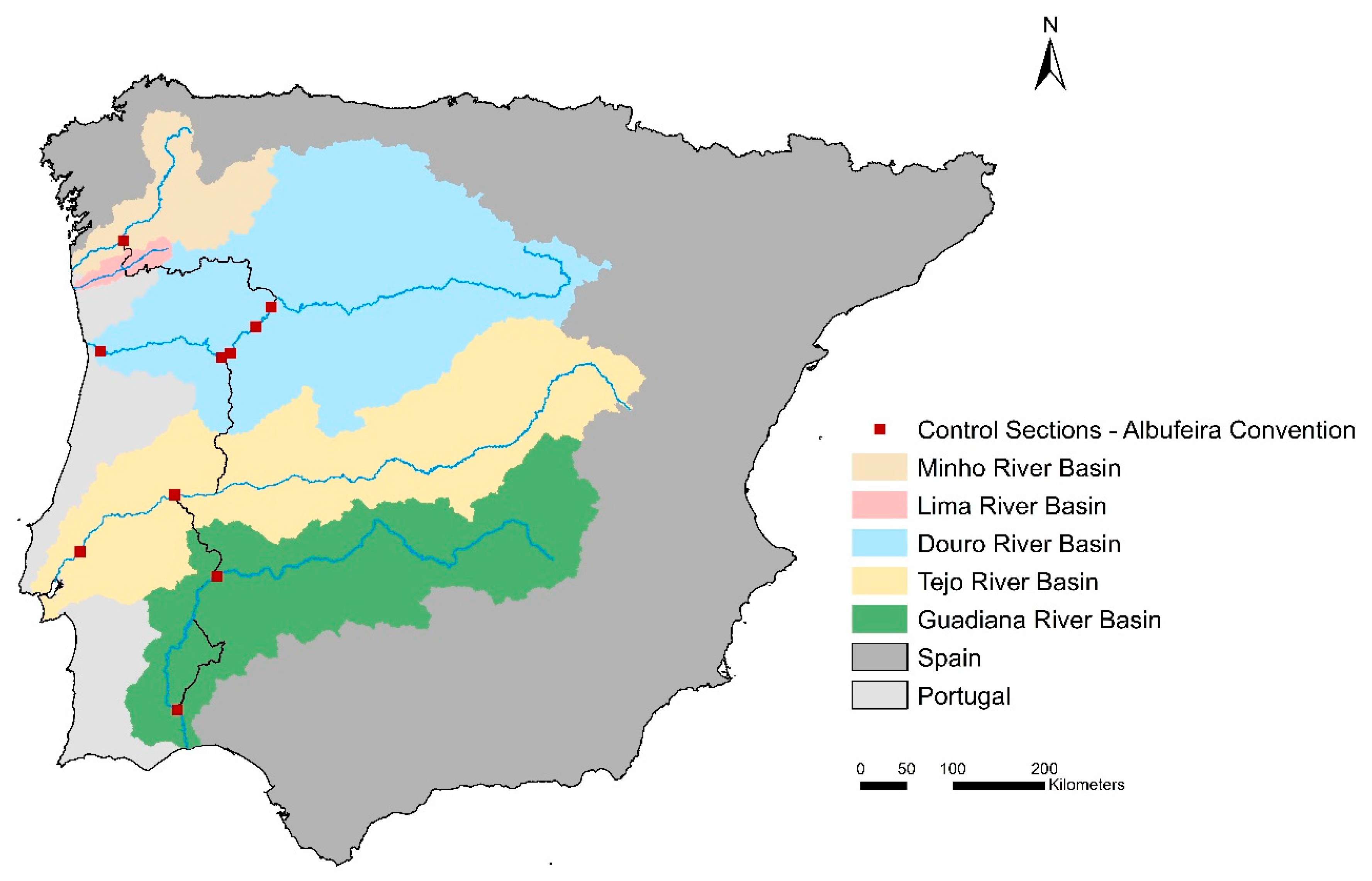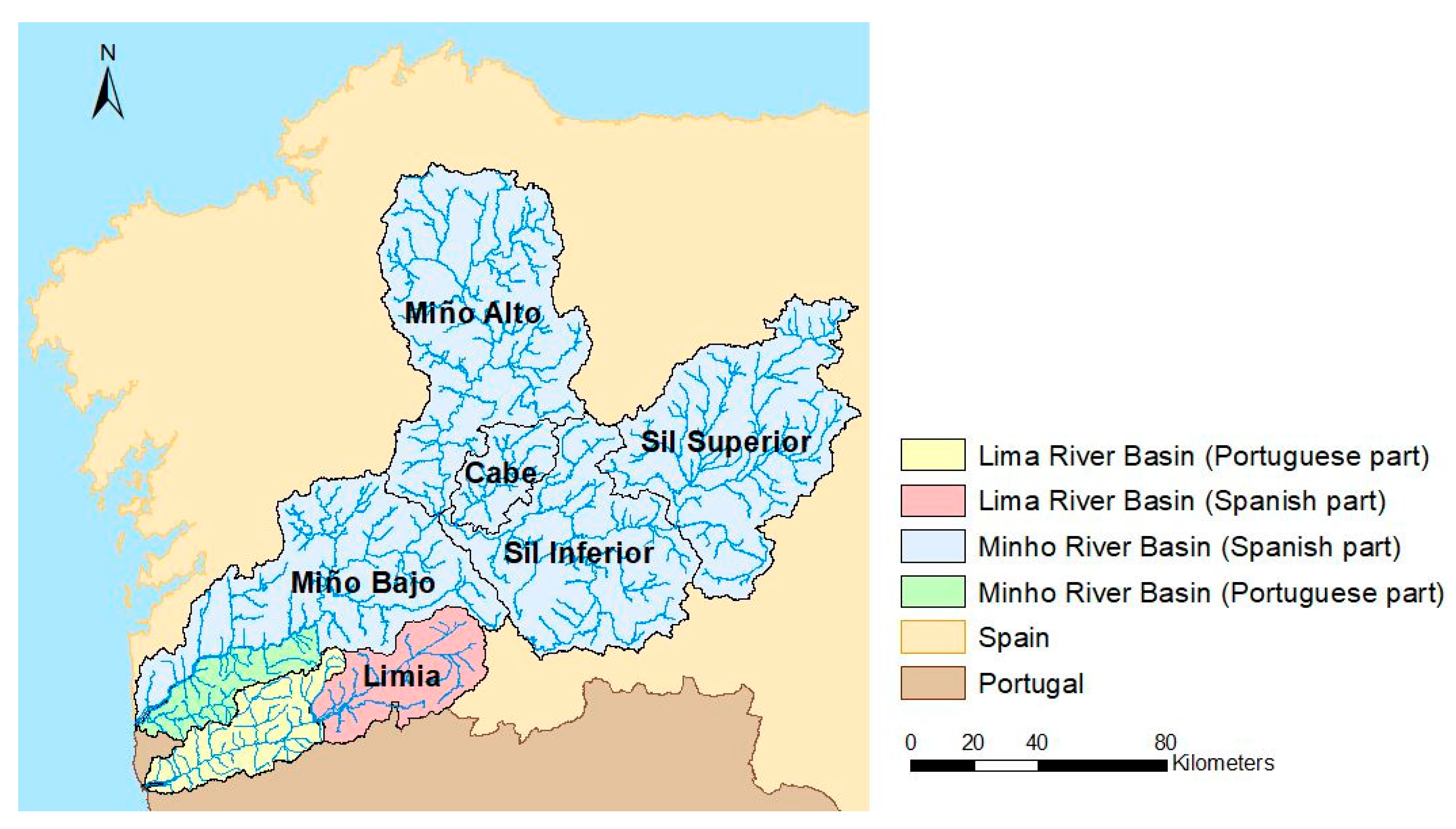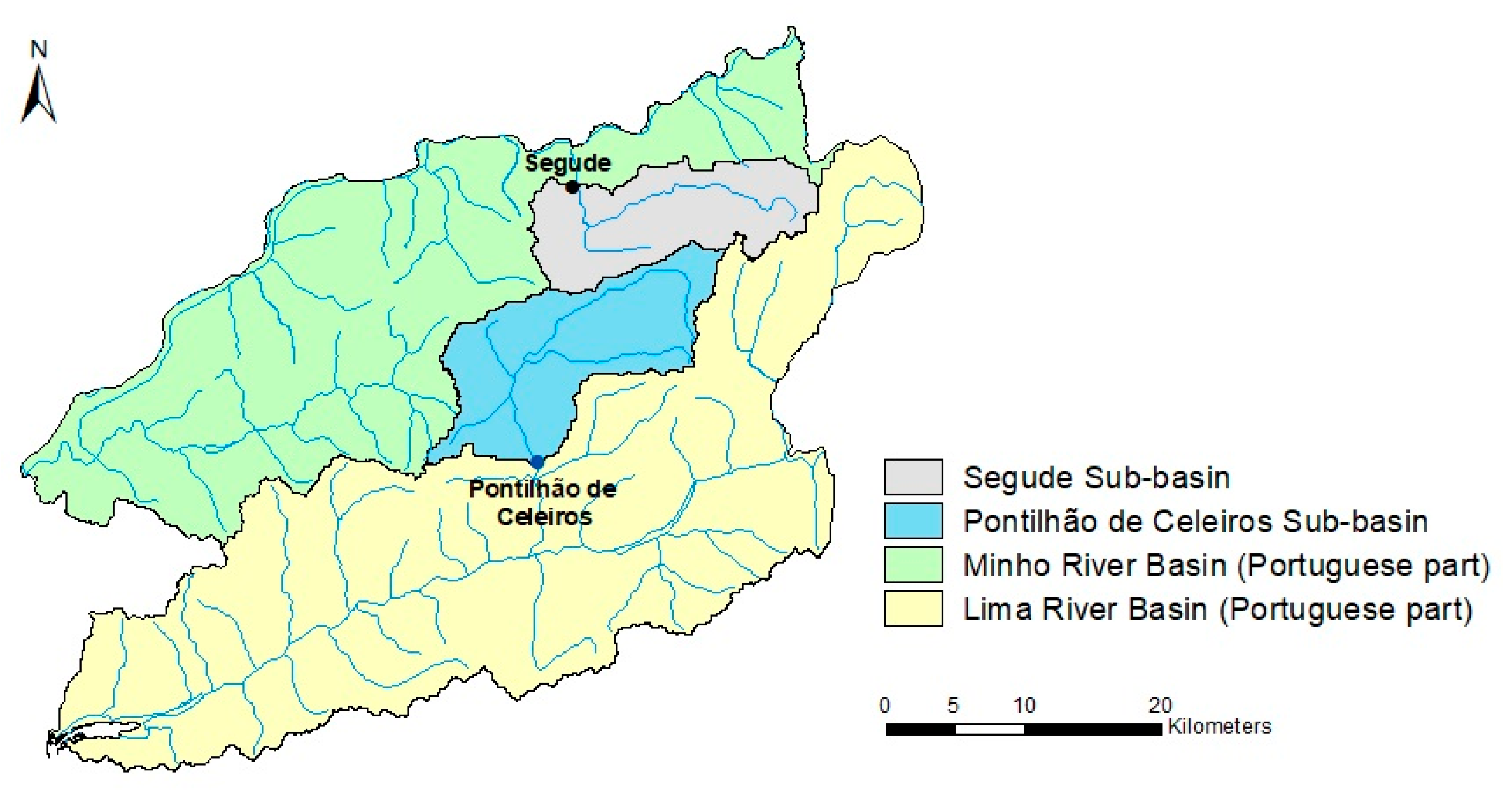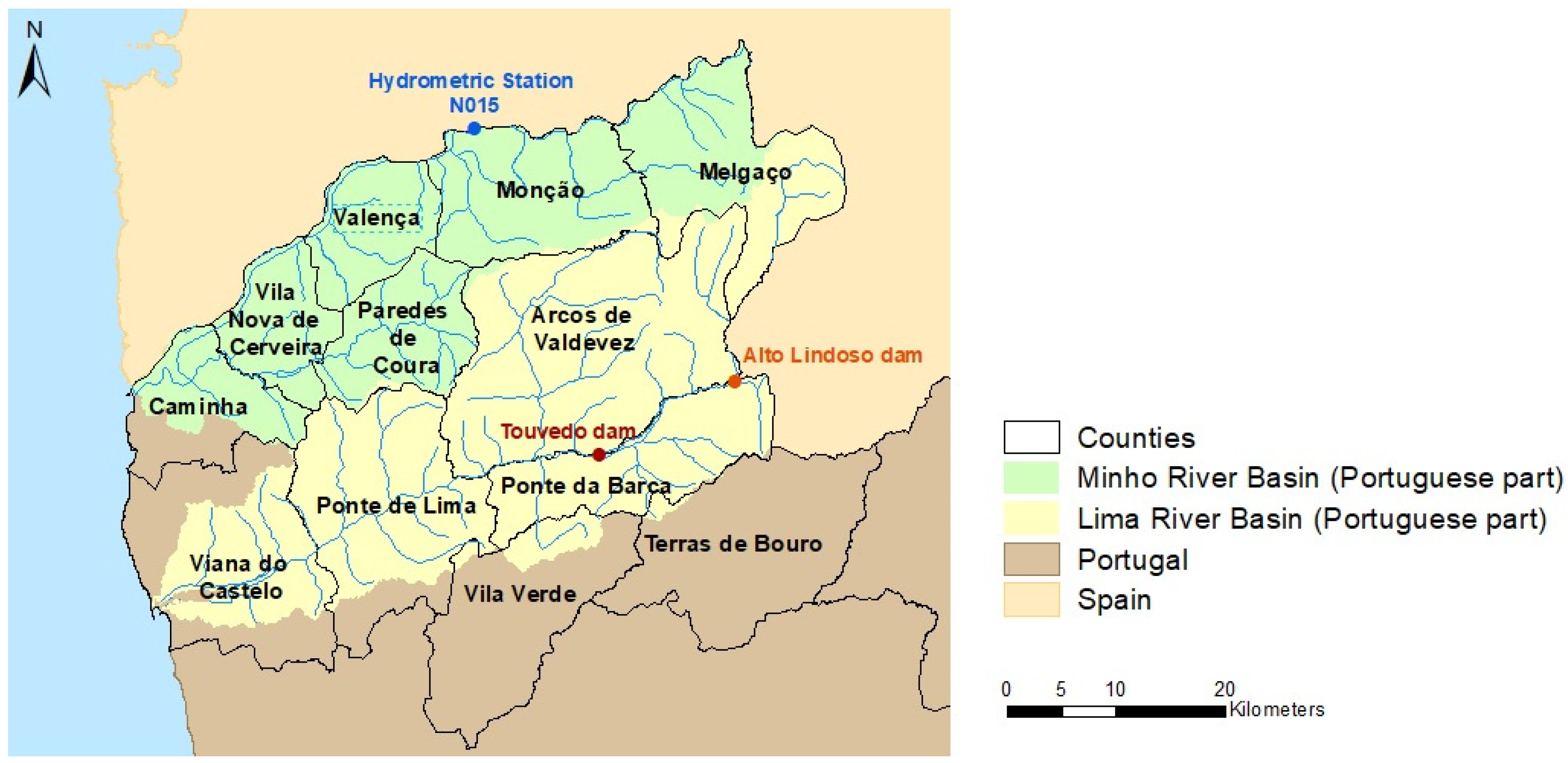Improving Transboundary Drought and Scarcity Management in the Iberian Peninsula through the Definition of Common Indicators: The Case of the Minho-Lima River Basin District
Abstract
:1. Introduction
2. Materials and Methods
2.1. Study Area
2.2. Methodology
2.2.1. Prolonged Drought
- 1.0: Maximum value of SPI/SRI in the reference series (October 1980–September 2012);
- 0.5: Median value of SPI/SRI in the reference series (October 1980–September 2012);
- 0.3: Value of SPI/SRI equal to −1.2813 (cumulative probability of occurrence of 10%): value established as the prolonged drought threshold;
- 0.0: Minimum value in the reference series (October 1980–September 2012).
2.2.2. Scarcity
- Pre-alert: median value of the reference series inflows per month;
- Alert: minimum inflow required to satisfy water demands and the environmental flows regime;
- Emergency: minimum inflow to satisfy water demands and 50% of the environmental flow regime.
- 1: maximum value of the reference series inflows per month;
- 0.5: Pre-Alert threshold;
- 0.3: Alert threshold;
- 0.15: Emergency threshold;
- 0: minimum value of the reference series inflows per month. If the minimum value is greater than any one of the Emergency thresholds, the value 0 will correspond to the minimum Emergency threshold.
3. Results and Discussion
3.1. Prolonged Drought
3.2. Scarcity
4. Conclusions
Author Contributions
Funding
Institutional Review Board Statement
Informed Consent Statement
Data Availability Statement
Conflicts of Interest
References
- Van Lanen, H.A.; Vogt, J.V.; Andreu, J.; Carrão, H.; De Stefano, L.; Dutra, E.; Feyen, L.; Forzieri, G.; Hayes, M.; Inglesias, A.; et al. Climatological risk: Droughts. In Science for Disaster Risk Management 2017: Knowing Better and Losing Less, 1st ed.; Poljansek, K., Marin Ferrer, M., De Groeve, T., Clark, I., Eds.; Publications Office of the European Union: Luxembourg, 2017; ISBN 978-92-79-60679-3. [Google Scholar]
- Kalis, G. Droughts. Annu. Rev. Environ. Resour. 2008, 33, 85–118. [Google Scholar] [CrossRef]
- Van Loon, A.F.; Van Lanen, H.A. Making the distinction between water scarcity and Drought using an observation-modeling framework. Water Resour. Res. 2013, 49, 1483–1502. [Google Scholar] [CrossRef]
- Vivas, E. Assessment and Management of Drought and Scarcity Situations. Application to the Guadiana Case. Ph.D. Thesis, Faculty of Engineering of the University of Porto, Porto, Portugal, 2011. (In Portuguese). [Google Scholar]
- Wilhite, D.A.; Sivakumar, M.V.; Pulwarty, R. Managing drought risk in a changing climate: The role of national drought policy. Weather. Clim. Extrem. 2014, 3, 4–13. [Google Scholar] [CrossRef] [Green Version]
- Hervás-Gámez, C.; Delgado-Ramos, F. Drought Management Planning Policy: From Europe to Spain. Sustainability 2019, 11, 1862. [Google Scholar] [CrossRef] [Green Version]
- European Commission. Directive 2000/60/EC of the European Parliament and of the Council of 23 October 2000 establishing a framework for Community action in the field of water policy. L 327 2000, 01-0073. In Official Journal of the European Communities, L327/1; European Parliament and the Council of the European Union: Brussels, Belgium, 2000; Available online: https://eur-lex.europa.eu/legal-content/EN/TXT/?uri=CELEX:32000L0060 (accessed on 20 October 2021).
- Zikos, D.; Hagedorn, K. Competition for Water Resources from the European Perspective. In Competition for Water Resources: Experiences and Management Approaches in the US and Europe, 1st ed.; Ziolkowska, J., Peterson, J., Eds.; Elsevier: Cambridge, MA, USA, 2017; pp. 19–35. [Google Scholar] [CrossRef]
- European Commission. Communication from the Commission to the European Parliament and the Council—Addressing the Challenge of Water Scarcity and Droughts in the European Union. COM(2007) 414 Final; Commission of the European Communities: Brussels, Belgium, 2007; Available online: https://eur-lex.europa.eu/legal-content/EN/ALL/?uri=CELEX%3A52007DC0414 (accessed on 20 October 2021).
- European Commission. Communication from the Commission to the European Parliament, the Council, the European Economic and Social Committee and the Committee of the Regions—Report on the Review of the European Water Scarcity and Droughts Policy. COM(2012) 672 Final; European Commission: Brussels, Belgium, 2012; Available online: https://eur-lex.europa.eu/legal-content/EN/TXT/?uri=CELEX:52012DC0672 (accessed on 20 October 2021).
- European Commission. Communication from the Commission to the European Parliament, the Council, the European Economic and Social Committee and the Committee of the Regions—Forging a Climate-Resilient Europe—the New EU Strategy on Adaptation to Climate Change. COM(2021) 82 Final; European Commission: Brussels, Belgium, 2021; Available online: https://eur-lex.europa.eu/legal-content/EN/TXT/?uri=COM:2021:82:FIN (accessed on 20 October 2021).
- European Commission. Report from the Commission to the European Parliament and the Council—Third Follow up Report to the Communication on Water Scarcity and Droughts in the European Union COM (2007) 414 Final. COM(2011) 133 Final; European Commission: Brussels, Belgium, 2011; Available online: https://eur-lex.europa.eu/legal-content/EN/TXT/?uri=CELEX:52011DC0133 (accessed on 20 November 2021).
- Maia, R.; Vicente-Serrano, S. Drought Planning and Management in the Iberian Peninsula. In Drought and Water Crises: Integrating Science, Management, and Policy, 2nd ed.; Wilhite, D., Pulwarty, R., Eds.; CRC Press: Boca Raton, FL, USA, 2017; pp. 481–506. [Google Scholar] [CrossRef]
- DR. Resolution of the Assembly of the Republic n° 66/99—Convention on Cooperation for the Protection and Sustainable Use of the Waters of the Portuguese-Spanish River Basins and the Additional Protocol. In Diário da República n° 191/1999, Série I-A de 1999-08-17 (Portuguese Government Official Journal); Assembleia da República: Lisboa, Portugal, 1999; Available online: https://dre.pt/dre/detalhe/resolucao-assembleia-republica/66-1999-434660 (accessed on 20 November 2021). (In Portuguese)
- DR. Resolution of the Assembly of the Republic no. 62/2008—Protocol of Review of the Convention on Cooperation for the Protection and Sustainable Use of the Waters of the Portuguese-Spanish River Basins (Albufeira Convention) and the Additional Protocol. In Diário da República n° 222/2008, Série I de 2008-11-14 (Portuguese Government Official Journal); Assembleia da República: Lisboa, Portugal, 2008; pp. 7961–7969. Available online: https://dre.pt/dre/detalhe/resolucao-assembleia-republica/62-2008-439852 (accessed on 20 November 2021). (In Portuguese)
- Chainho, P.; Martínez-Fernández, J. Iberian waters under European protection: Soft water in hard stone? In Proceedings of the X Congresso Ibérico de Gestão e Planeamento da Água, Coimbra, Portugal, 6–8 September 2018; ISBN 978-84-944788-5-7. (In Portuguese and Spanish). [Google Scholar]
- Arca, I. The Albufeira Convention: An analysis on the occasion of the Twentieth Anniversary of its Adoption. Rev. Catalana De Dret Ambient. 2019, 10, 1–38. (In Spanish) [Google Scholar] [CrossRef] [Green Version]
- Estrela, T.; Sancho, T. Drought management policies in Spain and the European Union: From traditional emergency actions to Drought Management Plans. Water Policy 2016, 18, 153–176. [Google Scholar] [CrossRef]
- Spanish Government. Order TEC/1399/2018, of November 28, approving the review of the special drought plans. In BOE núm. 311, de 26 de Diciembre de 2018 (Spanish Government Official Journal); Ministerio para la Transición Ecológica: Madrid, Spain, 2018; Available online: https://www.boe.es/diario_boe/txt.php?id=BOE-A-2018-17752 (accessed on 20 November 2021). (In Spanish)
- Confederación Hidrográfica del Miño-Sil. Special Plan of Action in Situations of Alert and Eventual Drought of the Spanish Part of the Miño-Sil River Basin District: Memory; CHMiño-Sil: Ourense, Spain, 2018; Available online: https://www.chminosil.es/es/chms/planificacionhidrologica/nuevo-plan-especial-de-sequia/plan-especial-en-situaciones-de-alerta-y-eventual-sequia-de-la-demarcacion-hidrografica-del-mino-sil-pes-version-definitiva-aprobada-y-vigente (accessed on 20 November 2021). (In Spanish)
- Comissão Permanente de Prevenção, Monitorização e Acompanhamento dos Efeitos de Seca. Prevention, Monitoring and Contingency Plan for drought Situations. 2017. Available online: https://apambiente.pt/agua/plano-de-prevencao-monitorizacao-e-contingencia-para-situacoes-de-seca (accessed on 20 November 2021). (In Portuguese).
- Maia, R. The Guadiana Case Study. In GAR Special Report on Drought 2021; United Nations Office for Disaster Risk Reduction: Geneva, Italy, 2021; Available online: https://www.undrr.org/publication/guadiana-case (accessed on 20 December 2021).
- Expresso. The Water No Longer Flows in the River: Images of Desolation Caused by Drought and Spain. Available online: https://expresso.pt/sociedade/2019-10-12-A-agua-ja-nao-corre-no-rio-as-imagens-da-desolacao-provocada-pela-seca-e-por-Espanha (accessed on 20 October 2021). (In Portuguese).
- Ministério do Ambiente e da Ação Climática. Flows of the Tejo River. Available online: https://www.portugal.gov.pt/pt/gc22/comunicacao/comunicado?i=caudais-do-rio-tejo (accessed on 20 December 2021). (In Portuguese)
- Do Ó, A. Transboundary Drought Management in the Guadiana: Applying the Conflict Risk Index. In Proceedings of the 5º Congresso Internacional de Ordenamento do Território—Gestão Partilhada de Recursos Hídricos Internacionais, Lisboa, Portugal, 27–28 October 2010. [Google Scholar]
- RISC_ML: Prevention of Flood and Drought Risks in the Minho-Lima International River Basins. Available online: http://risc-ml.eu (accessed on 20 December 2021).
- Agência Portuguesa do Ambiente. Minho and Lima River Basin Management Plan (RBD1) 2016–2021. Part 2—Characterization and Diagnostics (Annexes); APA: Lisboa, Portugal, 2016; Available online: https://apambiente.pt/agua/2o-ciclo-de-planeamento-2016-2021 (accessed on 20 November 2021). (In Portuguese)
- Ministério para la Transición Ecológica. Technical Instruction for the Preparation of Special Drought Plans and the Definition of the Global System of Indicators of Prolonged Drought and Scarcity; MITECO: Madrid, Spain, 2017; Available online: https://www.miteco.gob.es/es/agua/participacion-publica/PP-Agua-Orden-instruccion-tecnica-elaboracion-planes-especiales-sequia.aspx (accessed on 20 November 2021). (In Spanish)
- Spanish Government. Real Decreto 907/2007—Hydrological Planning Regulation. In BOE Núm. 162, de 7 de Julio de 2007 (Spanish Government Official Journal); Ministerio de Medio Ambiente: Madrid, Spain, 2007; Available online: https://www.boe.es/buscar/doc.php?id=BOE-A-2007-13182 (accessed on 20 November 2021). (In Spanish)
- McKee, T.; Doesken, N.; Kleist, J. The relationship of drought frequency and duration to time scales. In Proceedings of the Eight Conference on Applied Climatology, Anaheim, CA, USA, 17–22 January 1993. [Google Scholar]
- Agência Portuguesa do Ambiente. Douro River Basin Management Plan (RBD3) 2016–2021. Part 2—Characterization and Diagnostics (Annexes); APA: Lisboa, Portugal, 2016; Available online: https://apambiente.pt/sites/default/files/_SNIAMB_Agua/DRH/PlaneamentoOrdenamento/PGRH/2016-2021/PTRH3/PGRH_2_RH3_Parte2_Anexos.pdf (accessed on 20 November 2021). (In Portuguese)
- Agência Portuguesa do Ambiente. Tejo and Ribeiras do Oeste River Basin Management Plan (RBD5) 2016–2021. Part 2—Characterization and Diagnostics (Annexes); APA: Lisboa, Portugal, 2016; Available online: https://apambiente.pt/sites/default/files/_SNIAMB_Agua/DRH/PlaneamentoOrdenamento/PGRH/2016-2021/PTRH5A/PGRH_2_RH5A_Parte2_Anexos.pdf (accessed on 20 November 2021). (In Portuguese)
- Agência Portuguesa do Ambiente. Guadiana River Basin Management Plan (RBD7) 2016–2021. Part 2—Characterization and Diagnostics (Annexes); APA: Lisboa, Portugal, 2016; Available online: https://apambiente.pt/sites/default/files/_SNIAMB_Agua/DRH/PlaneamentoOrdenamento/PGRH/2016-2021/PTRH7/PGRH_2_RH7_Parte2_Anexos.pdf (accessed on 20 November 2021). (In Portuguese)
- Fundación Nueva Cultura del Agua (FNCA). FNCA Observations to the “Technical Instruction for the Preparation of Special Drought Plans and the Definition of the Global System of Indicators of Prolonged Drought and Scarcity”; FNCA: Zaragoza, Spain, 2018. (In Spanish) [Google Scholar]







| Lima (Portugal) | Limia (Spain) | Minho (Portugal) | Miño-Bajo (Spain) | |
|---|---|---|---|---|
| PD events | February 1989 | November 1981 | January 1989–February 1989 | August 1981 |
| June 1989–November 1989 | June 1989–November 1989 | June 1989–November 1989 | November 1981 | |
| November 1992 | December 1990 | March 1992–May 1992 | January 1989–February 1989 | |
| October 2002–November 2002 | March 1992–May 1992 | July 1992 | June 1989–November 1989 | |
| July 2004–August 2004 | May 1999–July 1999 | November 1992–December 1992 | December 1990 | |
| November 2004–February 2006 | March 2002–October 2002 | October 2002–November 2002 | November 1992 | |
| December 2007 | December 2004–March 2006 | July 2004–September 2004 | May 2002 | |
| February 2008–March 2008 | February 2008–March 2008 | November 2004–January 2006 | August 2002 | |
| June 2008–July 2008 | August 2008–November 2008 | February 2008–March 2008 | October 2002 | |
| May 2009 | December 2011–December 2012 | January 2012–April 2012 | December 2004–January 2006 | |
| August 2009–October 2009 | November 2015–December 2015 | November 2012 | December 2007 | |
| January 2012–April 2012 | April 2017–September 2017 | November 2015–December 2015 | February 2008–March 2008 | |
| November 2012 | April 2017–September 2017 | July 2008–August 2008 | ||
| November 2015–December 2015 | October 2008–November 2008 | |||
| April 2017–September 2017 | November 2011–December 2012 | |||
| November 2015–December 2015 | ||||
| April 2017–September 2017 | ||||
| Total months in PD | 50 | 65 | 50 | 58 |
| Lima (Portugal) | Limia (Spain) | Minho (Portugal) | Miño-Bajo (Spain) | |||||
|---|---|---|---|---|---|---|---|---|
| Status | Months | (%) | Months | (%) | Months | (%) | Months | (%) |
| Normality | 155 | 53.8 | 109 | 37.8 | 223 | 50.2 | 248 | 55.9 |
| Pre-Alert | 133 | 46.2 | 116 | 40.3 | 216 | 48.7 | 188 | 42.3 |
| Alert | 0 | 0.0 | 45 | 15.6 | 5 | 1.1 | 7 | 1.6 |
| Emergency | 0 | 0.0 | 18 | 6.3 | 0 | 0.0 | 1 | 0.2 |
Publisher’s Note: MDPI stays neutral with regard to jurisdictional claims in published maps and institutional affiliations. |
© 2022 by the authors. Licensee MDPI, Basel, Switzerland. This article is an open access article distributed under the terms and conditions of the Creative Commons Attribution (CC BY) license (https://creativecommons.org/licenses/by/4.0/).
Share and Cite
Maia, R.; Costa, M.; Mendes, J. Improving Transboundary Drought and Scarcity Management in the Iberian Peninsula through the Definition of Common Indicators: The Case of the Minho-Lima River Basin District. Water 2022, 14, 425. https://doi.org/10.3390/w14030425
Maia R, Costa M, Mendes J. Improving Transboundary Drought and Scarcity Management in the Iberian Peninsula through the Definition of Common Indicators: The Case of the Minho-Lima River Basin District. Water. 2022; 14(3):425. https://doi.org/10.3390/w14030425
Chicago/Turabian StyleMaia, Rodrigo, Miguel Costa, and Juliana Mendes. 2022. "Improving Transboundary Drought and Scarcity Management in the Iberian Peninsula through the Definition of Common Indicators: The Case of the Minho-Lima River Basin District" Water 14, no. 3: 425. https://doi.org/10.3390/w14030425
APA StyleMaia, R., Costa, M., & Mendes, J. (2022). Improving Transboundary Drought and Scarcity Management in the Iberian Peninsula through the Definition of Common Indicators: The Case of the Minho-Lima River Basin District. Water, 14(3), 425. https://doi.org/10.3390/w14030425








